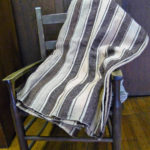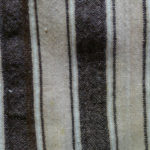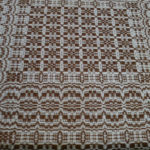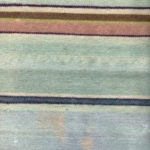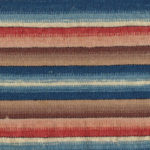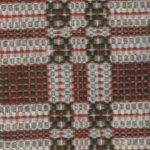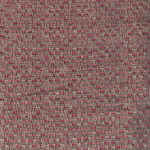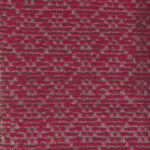Pine Mountain Settlement School
Series 09: BIOGRAPHY – Staff
Series 03: HISTORIES
Series 32: OBJECT COLLECTIONS
WELLS RECORD 13
PMSS Fireside Industries
1913-1928
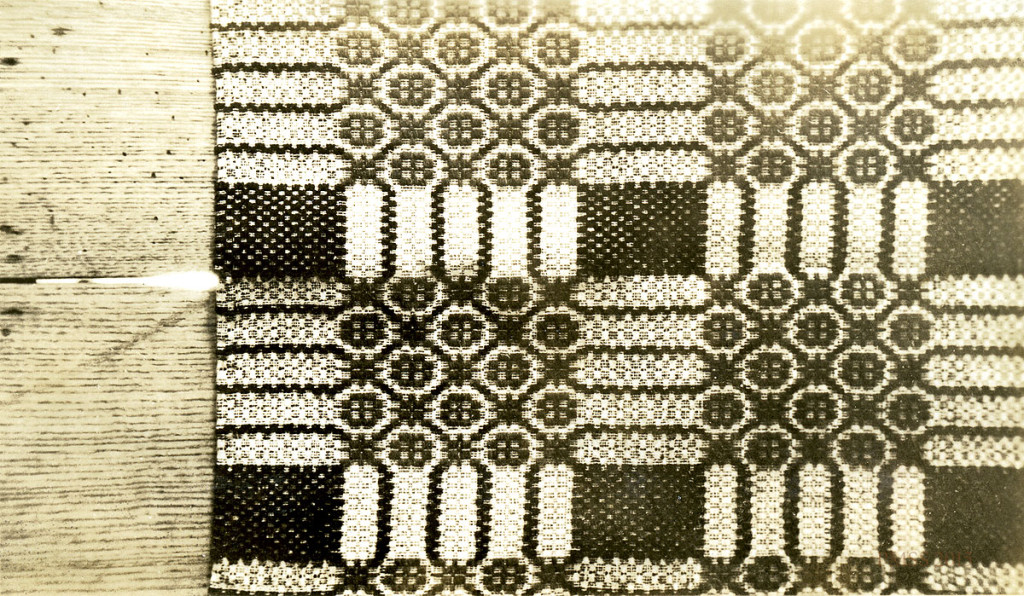
WELLS RECORD 13 PMSS Fireside Industries 1913-1928
TAGS: WELLS RECORD 13 PMSS Fireside Industries 1913-1928, Evelyn K. Wells, weaving, settlement schools, Fireside Industries, Florence Daniels, William Creech, Ethel de Long Zande, Katherine Pettit, Hindman Settlement School, Helen Wilmer Stone, vegetable dyeing, blue-pot, indigo, Farm House, Far House, community craftspeople, cottage industry, economics
WELLS RECORD 13 PMSS Fireside Industries 1913-1928 by Evelyn K. Wells is a detailed report of the Appalachian program that engaged weavers and craftsmen in a self-sufficient industry for the Pine Mountain Settlement School community.
WELLS RECORD 13 PMSS Fireside Industries 1913-1928: Fireside Industries
The ideal behind the development of this department has been to preserve all that was beautiful in the old mountain dyeing and weaving, letting only those things develop out of them that grew naturally, rather than to bring in outside ideas which did not belong to the mountains. Thus, we have used homespun wool, instead of that sent to the factory to be spun, and have avoided mercerized cotton and have religiously followed the old recipes for our dyes, never permitting the use of aniline dyes. that we are one of the few places in the mountains to appreciate to the full the artistic value of the old dyes, made of barks, roots and herbs, is evident from the fact that every weaving teacher who has come to us, has had to learn about the dying here.
Before there was any organized department, Miss Helen Wilmer Stone, housemother at Farm House for eight years, worked away at the dyeing and spinning as a sideline, losing no chance to get a recipe from a neighbor, or collect some beautiful piece of weaving, bartering old clothes for wool and the labor of preparing it, and one summer setting up a loom at Far House.
It was very early decided that when the Old Log House should be free of the hospital and the office and a family of children, it should be used for the weaving department. In 1921 this arrangement was possible, and Arlena Hall, Becky May Huff, Rhoda Melinda Lewis, Ralph Triplett and one or two others, went to weaving there. After a year, however, it was discovered that the place was too cold and dark and crowded for weaving, and the department reluctantly abandoned it for the present Library of the Schoolhouse. In 1924 it entered its present quarters in the new Girls’ Industrial Building.
The salary of the weaving teacher was paid for four years by the Southern Industrial Educational Association in Washington, but the breaking up of that organization terminated this arrangement. For the last two years, the Colonial Coverlet Guild of America [See Margaret Motter Talk for the Colonial Coverlet Guild of America] has contributed towards this salary.
IN 1921 the baskets, made for us for years by Mr. and Mrs. Wiliam Causey and sold by the office, were transferred to the Fireside Industries Department for handling.
In 1926 the Fireside Industries accounts were taken off the books of the School, to be kept independently by that Department.
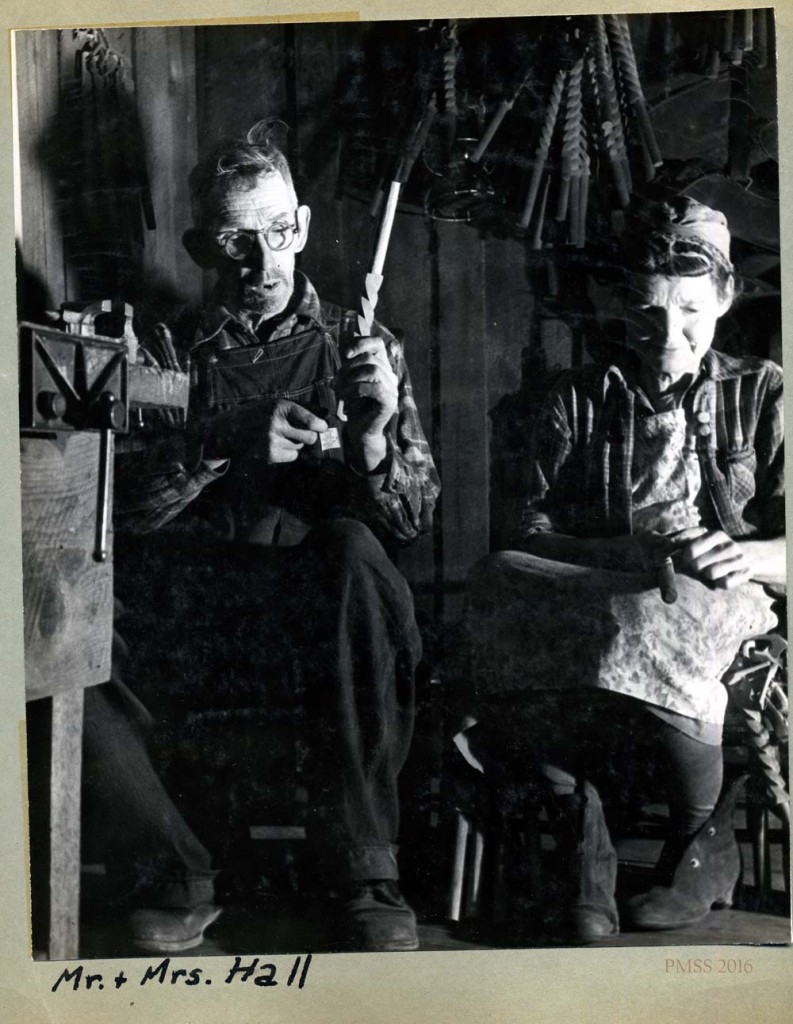
“Mr, & Mrs. Bennett Hall.” Man whittling & woman. [nace_II_album_080.jpg]
Because of the famous non-fading quality of the old blue coverlets of the mountains, we have always had the greatest interest and curiosity about the making of that color. Our attempts to reproduce the old fadeless blue, by means of the blue-pot recipe, were for years unsuccessful and the first really good blue was obtained in 1924 by Miss Lucy Nicholson [staff at PMSS] and Mrs. El Nolan. The subject of where to get good indigo was gone into. The old people whom we questioned had gotten their indigo through the country stores and we found that the brand they used was o longer obtainable. This led to the experiment of growing indigo plants, and in the fall of 1925, Miss Edna Fawcett, a former worker at the school came back to make indigo from our plants. Miss Fawcett was then in the employ of the Government and came at their expense, but at our request. [See booklet: Margaret Furry and Bess Viemont, Home Dyeing with Natural Dyes, 1935.]
The plants which the children had set out and tended through the difficulties of a very dry summer, carrying pails of precious creek water some distance every evening, were ready for her, and for days we watched as she worked. The boiling down of bushels of leaves to a final saucer-full of dry powder, with all the intermediate processes, revealed to us why the raising of indigo belonged to the days of slave labor and not for us. Wonderful blue dyes were made, and the blue-pot set, and a comparison made of the old blue-pot set, and a comparison made of the old blue-pot method of the mountains with the sulfuric acid method. It was demonstrated past doubt that the raising of indigo and making of our own dye is not for us, but that yarn dyed in the mountain blue-pot, from commercially prepared indigo, is a better blue than that obtained in any other way.
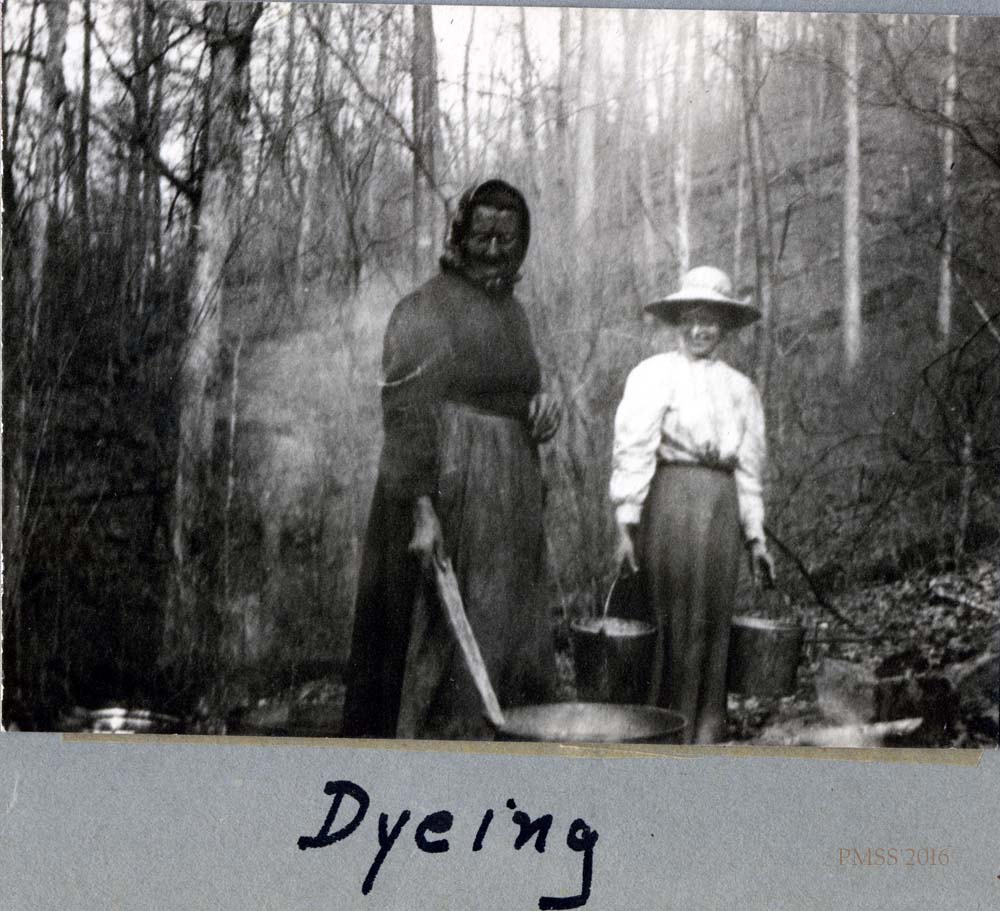
“Dyeing.” Two women with buckets and vat. [Aunt Sal and Ethel de Long ?] [nace_II_album_062.jpg]
It is interesting to remember that Becky May Huff, the first girl ever to come to Pine Mountain, wove the first coverlet in the department in 1922, and for some time was the only student who could do pattern weaving; that Allene Nolan, the first girl to learn weaving at Pine Mountain and set upon her loom at home, helped by the selling of her blankets to pay for the Nolans’ new kitchen and stove to say nothing of stimulating her mother to take up her forgotten art again and become our finest coverlet weaver; that Oma Creech learned to weave at the School, and worked on Aunt Sal Creech‘s old loom, her grandmother dyeing the wool for her and setting up the loom again. Her first blanket was a copy of a very old one in the Creech family. When Hattie Howard, who had learned at the School and set up her own loom at home, came back for a summer vacation with a coverlet which paid her whole year’s schooling; and when later Delphia Turner brought in three at the end of a summer, this paying for herself and a little sister for a year, weaving as a profitable trade for our girls was on its feet.
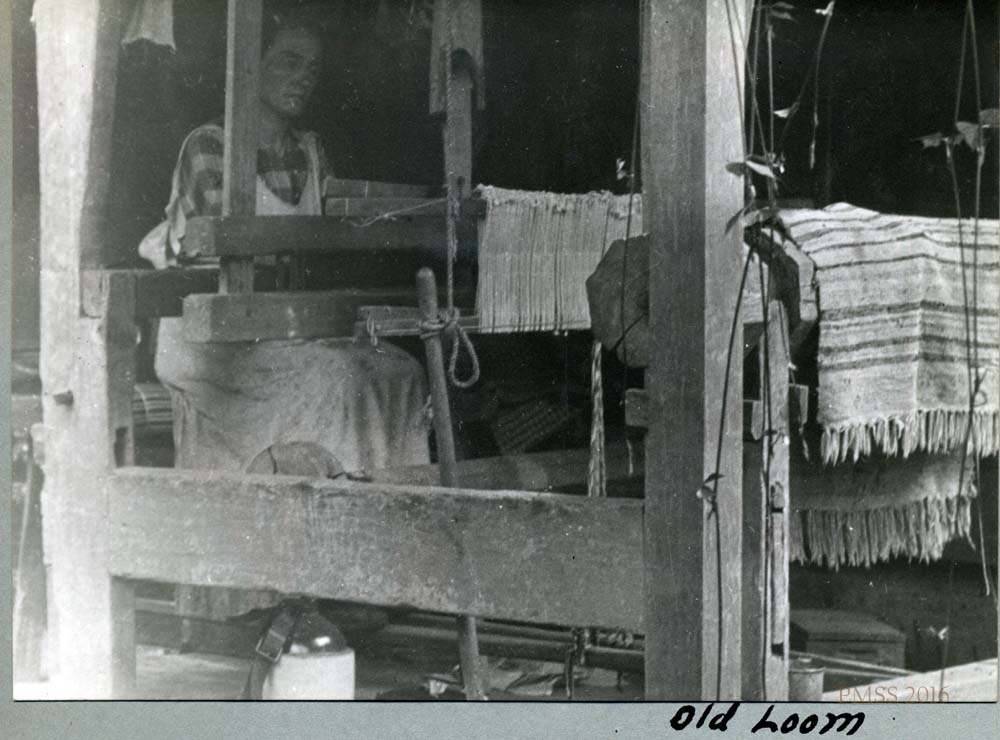
Woman weaving at “Old Loom.” [nace_II_album_020.jpg]
The Fireside Industries Department has grown in the face of great difficulties. Before there was any organized department, with a full -time teacher, there was constant education going on; children were being taught to value the old pieces in the School ; Miss Pettit’s and Mrs. Zande’s beautiful collections were always on display in their own houses and being loaned to the others; every new worker who came in, was told their history and significance; every bit of weaving, even a few feet from an old coverlet or blanket, was saved, every chance was given to encourage interest. Uncle William planted our flax crop the first year, all the neighbors who spun could sell their yarn at the school. Everyone looked forward to the day when we should be gathering all these threads of interest and activity into one department.
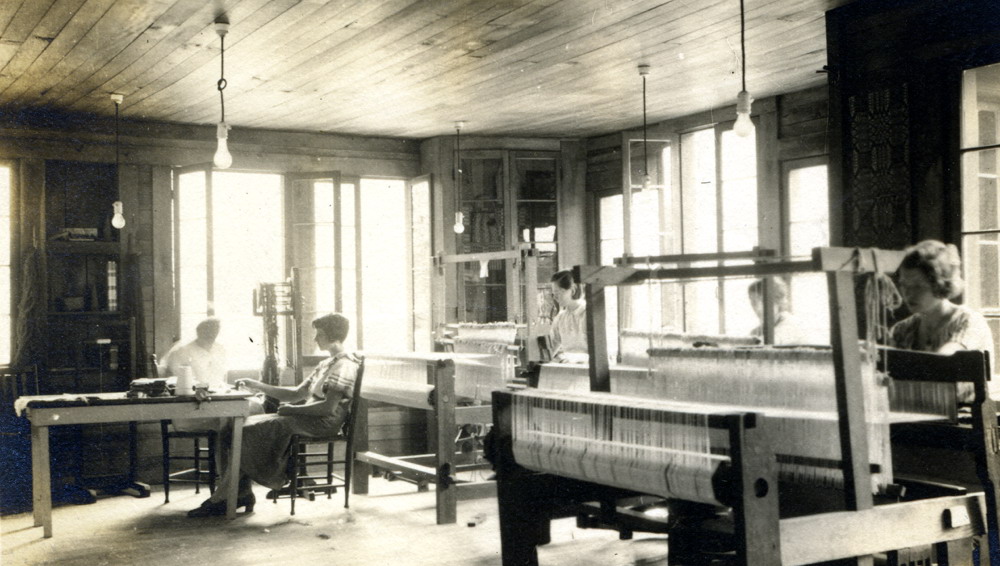
Girl’s Industrial. Interior view of weaving room with looms. [II_6_swimming_draper_boys.jpg]
And when it came to country people taking it up again, the growth is even more surprising, for life in a mountain home is much more difficult than in a school community; there is the heavy farm work that takes in every member of the family during crop time, there are the boarders to be cooked for, there are the mistakes in the work, — the breaking of a thread or the failure of the dye-pot, which must wait till the next visit of the weaving teacher. The one day a week that she could give to extension work did not bring her very often to the Head of Leatherwood, or to Incline, or Big Laurel.
Considered in the light of these difficulties, the selection of facts given below shows a tremendous accomplishment and a fine record.
WELLS RECORD 13 PMSS Fireside Industries 1913-1928: CHRONOLOGY
| YEARS | IN CHARGE | LOC. | WORK | SALES |
| 1921-1922 | Miss Daisy Bilbrey in charge | at Old Log | 6 children at work. Output: 58 yards blanket material, 15 yards linsey woolsey, curtains, rugs, counterpane material, etc | Sales: $464 |
| 1922-1923 | Miss Sabrina Ritchie in charge | at Old Log | 34 blankets and 45 yards rug material made. Allene Nolan and Oma Creech started at their own looms. | Sales: $1,015 |
| 1923-1924 | Miss Lucy Nicholson in charge | at Schoolhouse | The record for two months alone shows 6n yards coverlet material, 6 yards rug material, 3 blankets, counterpanes and tied lace made. The first successful blue-pot was set, weaving notebooks were started, the regular weaving class began, the student making themselves homespun dresses. Kenneth Nolan started work at his own loom. | Sales: $388 |
| 1924-1925 | Miss Eleanor Stockin in charge | at Schoolhouse and later at Girl’s Industrial Building | 3 new looms, 12 children working. Output: Martha Washington counterpane, 3 Tennessee Trouble coverlets. 2 Cross coverlets, 60 yards. rag rug material, 17n blankets, 6 runners., 14 yards curtain material, strips of samples, work n the summer and Winter weave. Many of these pieces went to the furnishing of the Old Log House. A loom was set up at the Medical Settlement. Mrs. E. Nolan made 7 coverlets, Mrs. Kenneth Nolan 6 blankets. The Hall brothers started work on Bear Branch. | Sales: $797 |
| 1925-1926 | Miss Florence Daniels in charge | Loom at Line Fork | Miss Fawcett’s indigo experiment. | Sales: $1164 |
| 1927-1928 | Miss Barbara Jenkins doing extension work | Getting people to make tied lace and tufted counterpanes. | Sale: $2,474 | |
ADDENDA: A Weaving Teacher’s Report, 1926-1929
(Miss Florence Daniels, weaving teacher for 1926-1929, sends in the following report, which, although it duplicates somewhat the subjects that have already been said, is worth quoting.)
WEAVING DONE BY OUTSIDE WEAVERS — 1926-1929
| WEAVERS | WEAVINGS |
| Jane Nolen | 29 Coverlets and pieces (including five Coverlets woven for her 5 children |
| Jona Creech | 2 Blankets. (Had to stop weaving because of heart trouble.) |
| Hattie Howard | [See below] |
| Margaret Howard (Hattie’s mother) | 11 Coverlets and pieces |
| Ophia Jackson | 11 blankets. 3 coverlets and pieces |
| Delphia Turner | 5 Coverlets and pieces |
| Tressie Wilder | 3 Blankets |
| Redia Nolan | 2 Blankets |
| Mrs. Crit Lewis | 2 Blankets |
| Jim Lewis | 2 Blankets |
| May Morgan | 2 Blankets |
| Ruth Burdine | Coverlet pieces |
| Alice Boggs | Had not finished anything. She has since done several things and is planning to weave this summer. |
The two things which give me most satisfaction among the few I accomplished are:
Teaching Mrs. Nolan how to do the Summer and Winter weave. She had never done any before. This was a chance to repay her a little for all she had done in helping the weaving teachers. Much credit is due to Becky May Huff in this, for she helped Mrs. Nolan adjust her loom after I had gone. I started Mrs. Nolan just before I left the first spring. I took Becky May down there when we tied up the loom, so she would be sure to understand it. It always takes a lot of adjusting when a loom has a different tie-up, especially when new harnesses and treadles have been added. The cords stretch and have to be evened. Beck May helped with that after I had gone. As far as I know, all that Becky May knew about Summer and Winter weave she had learned that same year when I taught her how to weave a simple pattern in that, on my loom. Mrs. Nolan has become very much devoted to Summer and Winter weave, and says she likes to weave that kind better than the other.
GALLERY: WELLS RECORD 13 PMSS Fireside Industries 1913-1928
- Fireside Industries weaving. [weaving_pmss_01_mod.jpg]
- Fireside Industries weaving. [weaving_pmss_01a_mod.jpg]
- Fireside Industries weaving. [weaving_pmss_02b_mod.jpg]
- Fireside Industries weaving. with natural dyes. [weaving_pmss_fh-002_mod.jpg]
- Fireside Industries weaving. [weaving_pmss_fh_003rev2_mod.jpg]
- Fireside Industries weaving. [weaving_pmss_fh_005_mod.jpg]
- Fireside Industries weaving. [weaving_pmss_fh_006_mod.jpg]
- Fireside Industries weaving. [weaving_pmss_fh_006rev_mod.jpg]
ADDENDA: (Continued)
The other thing which gives me a nice feeling is some of the work I did in starting people weaving in their homes. Mrs. Ophia Jackson had never woven a bit and hardly seen a loom until she decided to try to support herself and her three little children after her husband was shot. Dr. Withington deserves a lot of credit for helping her to get a loom, and for encouraging her. Ophia did not have much self-confidence, and I was afraid she would get too discouraged and stop before she got a good start. I made a good many frantic trips down to big Laurel during my free hour and dinner time ad a bit more, just to encourage her and let her know I was behind her work. Since Alafair (my horse) was lame, I hiked, and my! how I hurried She did nicely, as we knew she would, and enjoyed weaving, and found it worthwhile financially. The next spring when she was living over on Leatherwood I taught her how to weave coverlets. She certainly proved an apt pupil. I have heard from someone since that she was making all her living expenses by her weaving, but I can’t vouch for that.
Of course, the Howards’ weaving was another pleasant achievement. Certainly, Hattie [Howard] can be proud of having taught her mother how to weave coverlets and to do the vegetable dyeing.
May Morgan, one of the last whom I taught, has done quite a lot of blanket weaving since I left, according to her sister, and has been pleased with her results.
Tressie Wilder did some nice weaving just before I left, and has woven several blankets. She had been wanting to weave for a long time, and finally, Dorse made her a loom. He was the loom-maker for most of the people who began to weave in their homes. Since he did that on rainy days and in his spare time, that brought him some extra money.
The first year most of my extension work consisted in tramping along the road and stopping in at the various houses to teach the women how to make tied lace. I remember how I found one woman who was left-handed and, on the spur of the moment, I had to teach her left-handed. After that, I found another woman who was left-handed, and it was very simple to teach her.
I had a weaving class at Big Laurel with several very enthusiastic weavers. “Little Alice” Boggs, who is one of the weaving girls here (Berea) got her first taste of weaving at that time. Unfortunately, the loom was burned in the fire and there was no opportunity to continue that class.
The first half of the third year I was able to use Nell (horse), and of course was able to cover more territory in less time. The last half of that year, and the whole of the net, when I had Alafair (horse), I was able to [get] around even more, because I could always depend on having a horse, without worrying about whether plowing, or mail-time or something else would interfere with my trips.
The receipts for last year (1928-1929) amounted to $2,583.60.
Another change we made the second year, besides taking over the accounts, was to attend to weighing and stamping the packages we sent out. It takes a good deal of time to calculate all that business —zone, weight, insurance, etc.
I never felt particularly satisfied with the dyeing as a whole. It is something which needs careful and undivided attention, which I could rarely give to it.
The mail orders grew a lot, I think.
See Also:
EVELYN K. WELLS Staff Interim Director Biography
DANCING IN THE CABBAGE PATCH Weaving at PMSS Beginnings
KATHERINE PETTIT Weaving at PMSS Beginnings
EVELYN K. WELLS Guide to Excerpts from Letters Home 1915-1923
Back To:
WELLS RECORD OF PINE MOUNTAIN SCHOOL Guide 1913-1928 – 22 sections of early in-depth history of the Pine Mountain Settlement School gathered by Evelyn K. Wells from 1913 to 1928.
**********
EVELYN K. WELLS Publications and Talks
Wells, Evelyn K. The Ballad Tree: A Study of British and American Ballads, Their Folklore, Verse and Music, Together with Sixty Traditional Ballads and Their Tunes. New York: Ronald Press, 1950. Print.
EVELYN K. WELLS “A Little True Blue American,” Over Sea and Land: Our Southern Mountains, November 1920, p. 140.
EVELYN K. WELLS Harvard University Address 1955 – Re: Folk Music. July 21, 1955.

